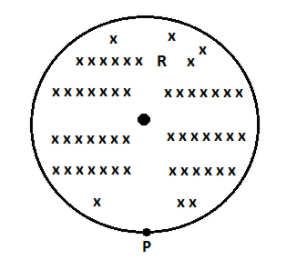Question
Question: A uniform magnetic field of induction \(B\) is confined to a cylindrical region of radius \(R\). The...
A uniform magnetic field of induction B is confined to a cylindrical region of radius R. The magnetic field is increasing at a constant ratio of dtdB. An electron of charge q, placed at the point P on the periphery of the field experiences an acceleration:

(A) 21meRdtdB toward left
(B) 21meRdtdB toward right
(C) meRdtdB toward left
(D) 21meRdtdB zero
Solution
Here we consider a magnetic field that is uniform and confined to a cylindrical region. The magnetic field is increasing at a constant ratio. If we place an electron at a point on the periphery of the field, it will experience an acceleration. Here we have to find the acceleration experienced by the electron placed at the periphery of the cylindrical region of a uniform magnetic field.
Complete step by step solution:
There will be an electric field induced at the point P.
The electric field induced at this point can be written as, ∫E.dl=dtd(AB)
where E stands for the electric field dl stands for the small element of length, A stands for the area of the region, and B stands for the magnetic field.
The above equation can be written as,
⇒ E.∫dl=AdtdB
From the figure, we can write
∫dl=2πR
and A=πR2
Substituting these values within the above equation, we get
E(2πR)=(πR2)dtdB
From the above equation, we can write
E=2πRπR2dtdB
Cancelling the common terms, we get
E=2RdtdB
Applying the right-hand thumb rule, if the curl of the fingers represents the direction of the induced electric field the thumb points towards the change in the magnetic field.
Hence here the induced electric field will be towards the right.
We know that the force, F=ma
From this, we can write
⇒ a=mF
We can write the force here as, F=eE
where e stands for the charge and E stands for the electric field.
Then the above equation will become
a=meE
Substituting E=2RdtdB in the above equation, we get
⇒ a=21meRdtdB
The electron will be accelerated towards a direction opposite to the direction of the electric field.
Therefore the acceleration of the electron will be,
⇒ a=21meRdtdB toward left
The answer is:
Option (A): a=21meRdtdB toward left
Note:
The direction of electric and magnetic fields are found by applying various thumb rules. Whenever the magnetic flux linked with a closed circuit changes an e.m.f is induced in the circuit. This phenomenon is called electromagnetic induction. The e.m.f induced in the circuit is called induced e.m.f.
